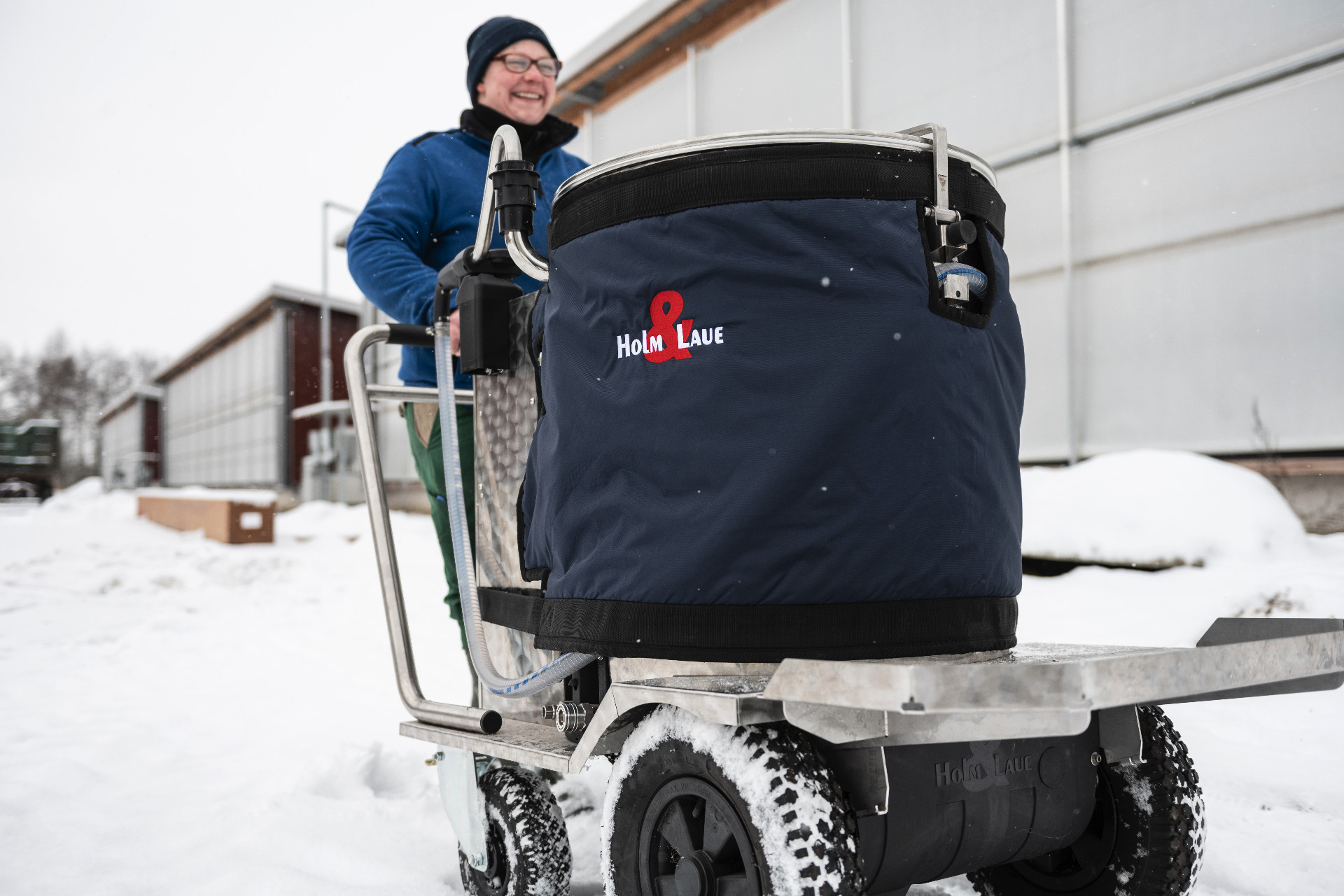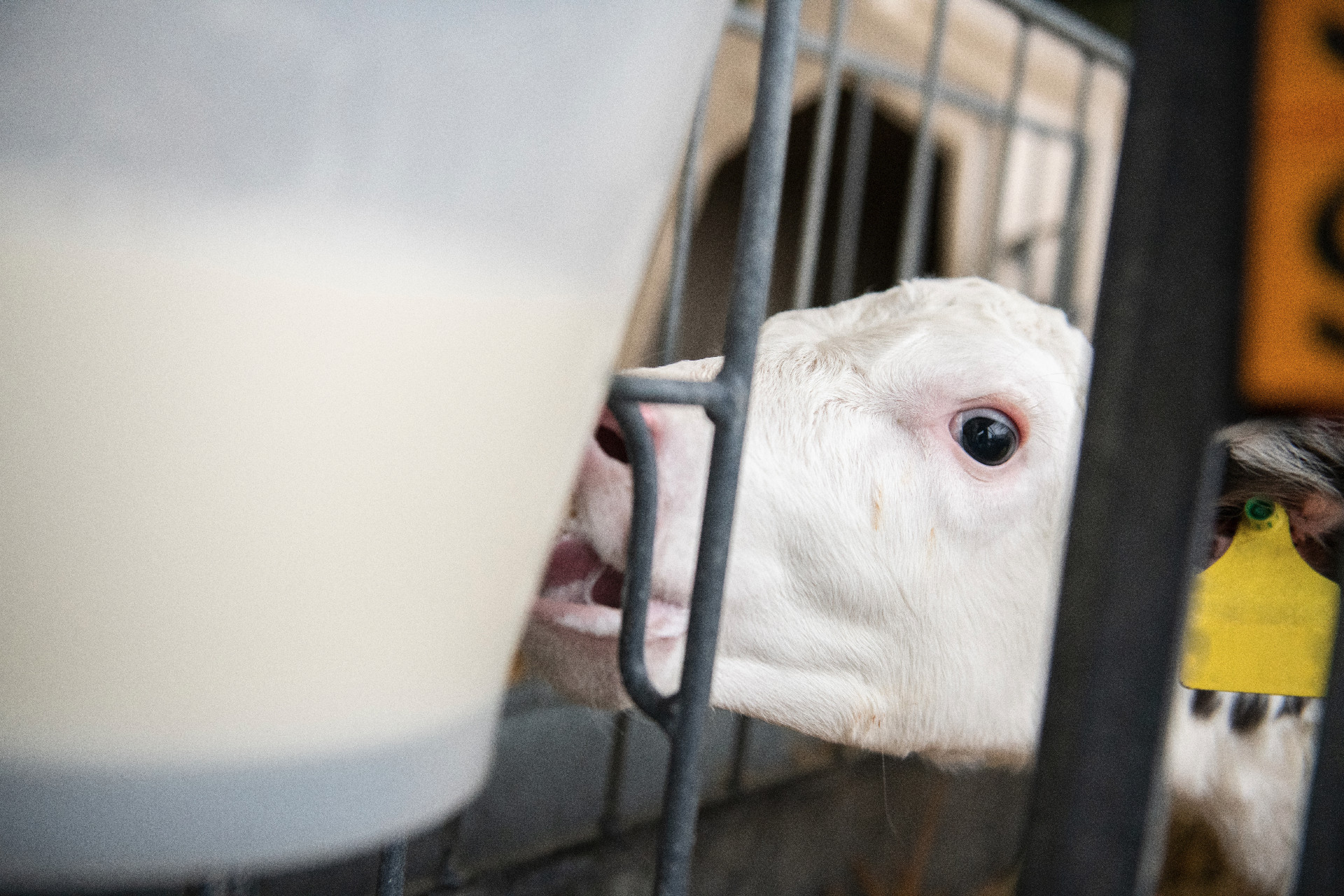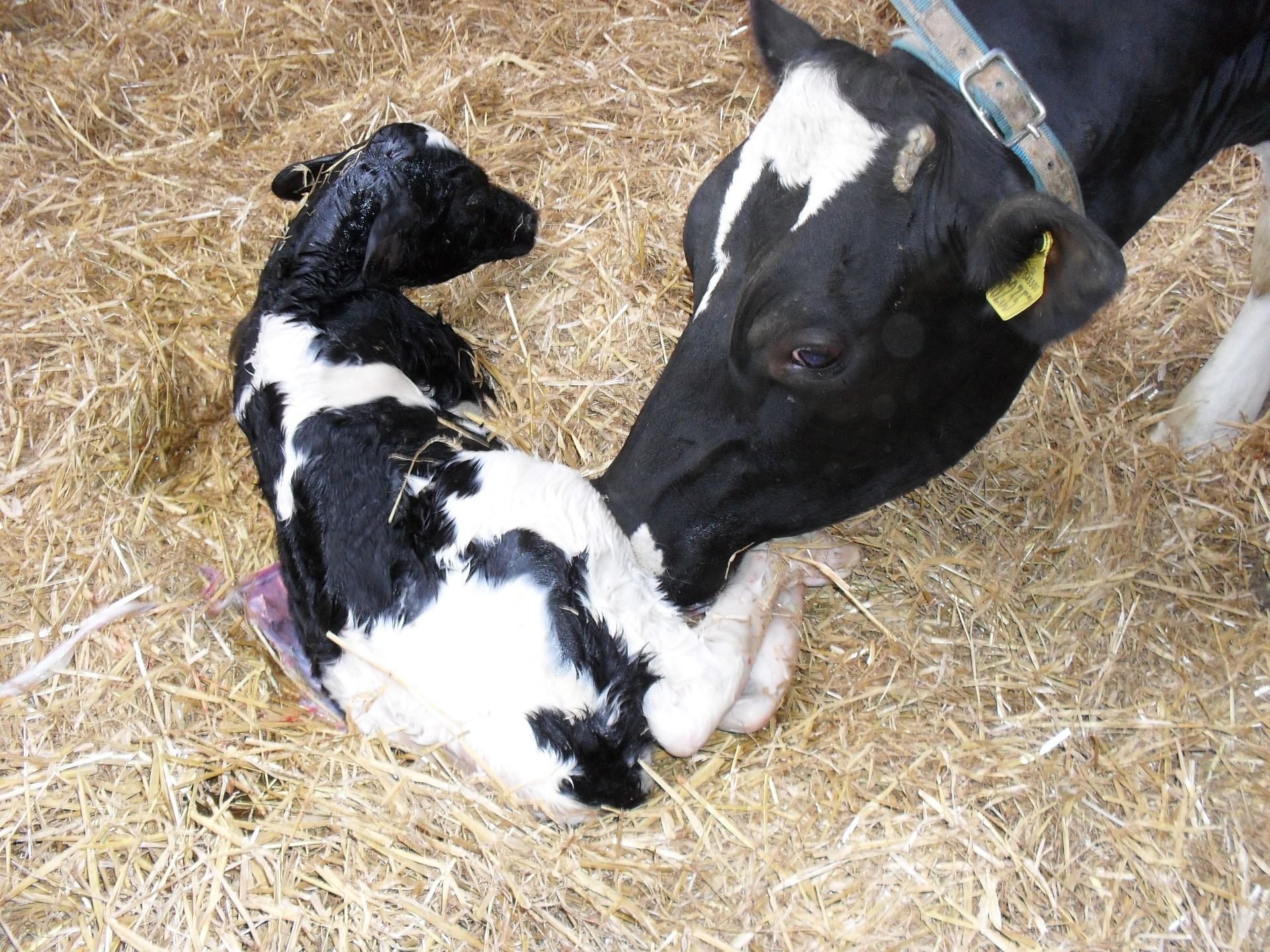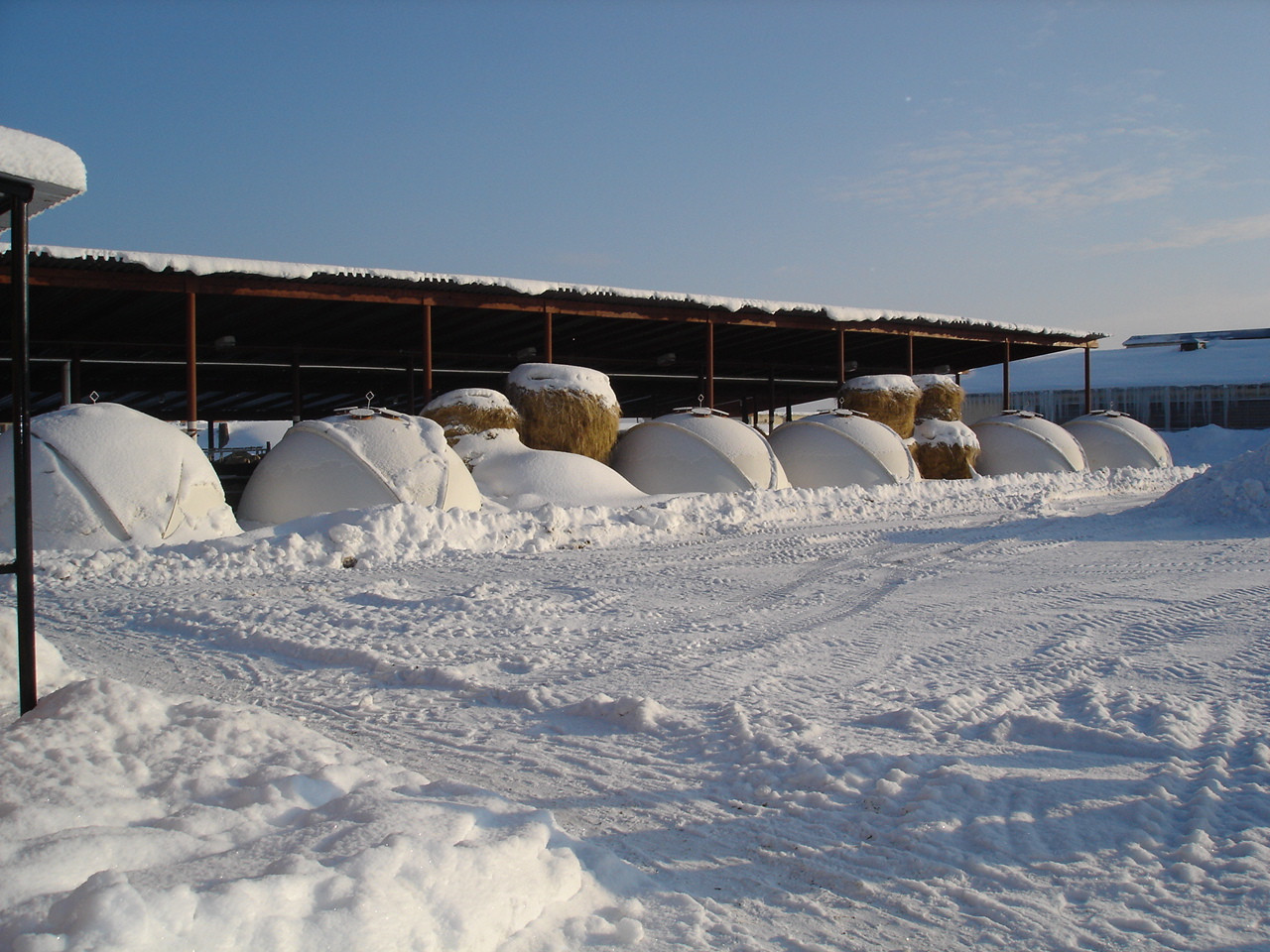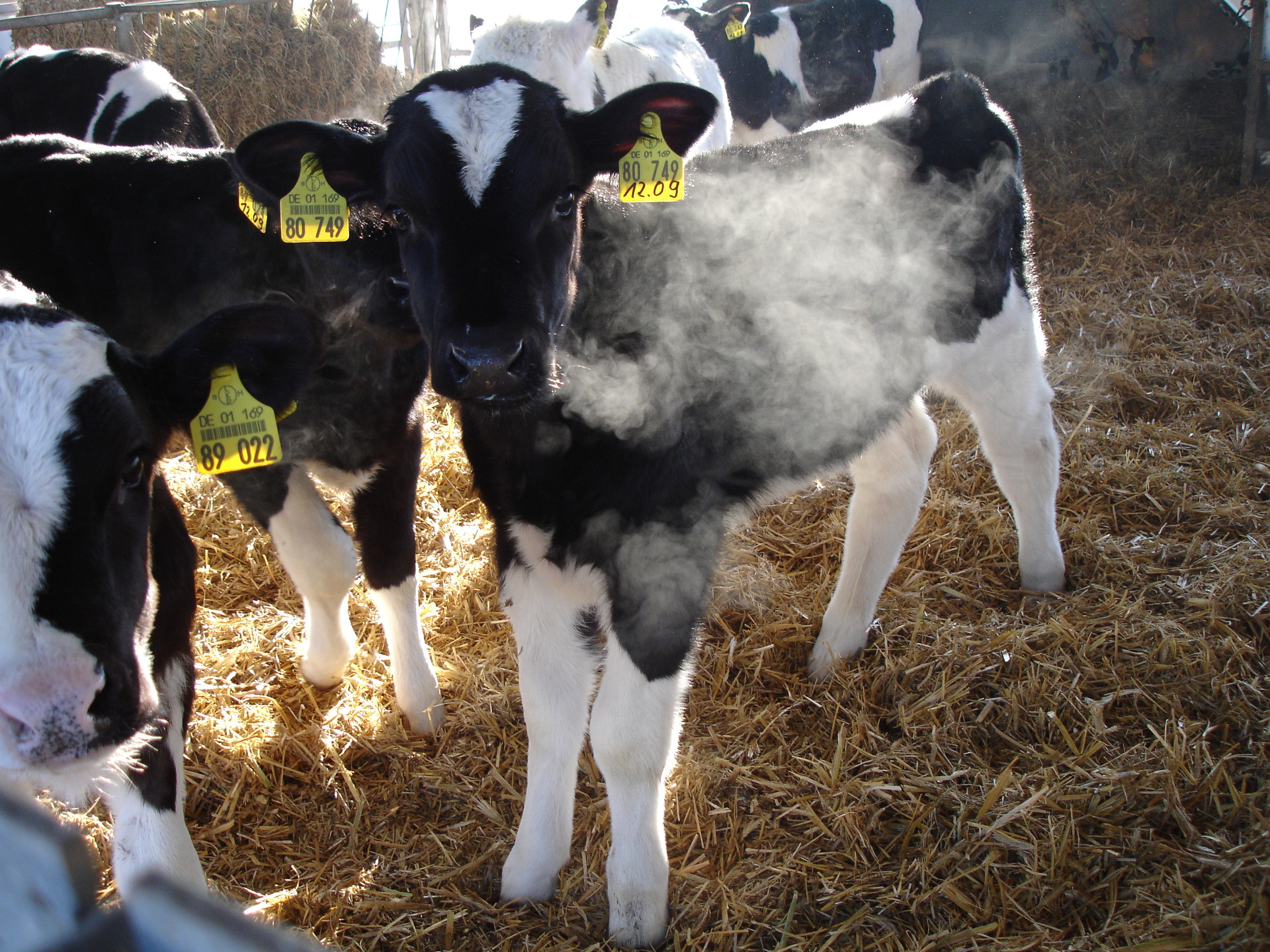Calf management in winter – part 2
22. Dezember 2021 — Calf Feeding, Calf Husbandry, Calf management — #Colostrum #Power supply #Calving assistance #Calf Health #Calf jackets #Management #Nesting score #Winter management #Gains12 tips for good calf management in winter
The first part of this blog on winter management focuses on the why: What are the needs of calves in the cold season and what are the effects of inadequate management on the health and performance of our calves? This article explains the details that matter when the days get shorter and life gets harder for your calves.
This article is about
-
1. Feed more milk.
-
2. Check ad libitum feeding
-
3. Delay weaning
-
4. Check the temperature of the feed
-
5. Giving colostrum
-
6. Increase concentrated feed intake
-
7. Water
-
8. Calving assistance
-
9. Calf jackets or blankets
-
10. Bedding (nesting score)
-
11. Control draughts and wind
-
12. Be prepared for emergencies
1. Feed more milk.
If the calves are fed restrictively (< 10 l milk per day) and the temperature falls below the 5-10 °C mark for an extended period, feeding programs need to be adjusted and more milk fed. An initial increase of approx. 10 % is sufficient. However, increases of 20–30 % are appropriate at temperatures below freezing.
- When feeding using buckets with the MilkTaxi, you could simply increase the amount of milk or add a third feed, for example at lunchtime.
- Increases in quantity can be achieved at the feeder simply by changing the feeding program.
- You could also increase the CMR concentration instead of the quantity. However, care should be taken to ensure that the concentration is not too high in order to prevent digestive problems resulting from the quality of the CMR. A limit of 15-16 % dry matter in the feed should not be exceeded. The CMR manufacturer will provide you with more detailed information.
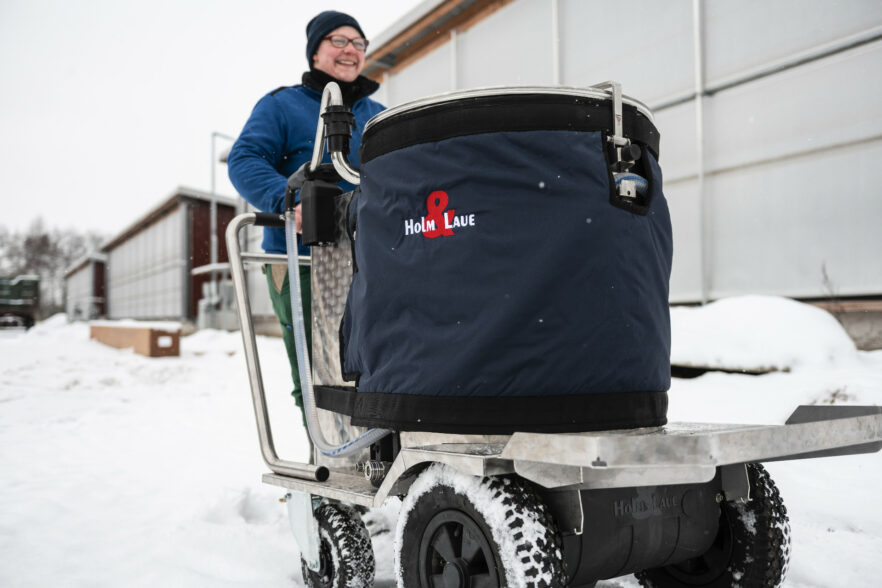
2. Check ad libitum feeding
It is not necessary to increase the quantity if calves are already feeding ad libitum. Calves take what they need.
However, heavy frost can cause problems. Calves cannot take any milk if the teat or even the entire bucket freezes. For this reason, you should also plan a third feed in such a period and remove the buckets as soon as they are in danger of freezing. The extra effort involved in removing the frozen milk alone can be huge.
3. Delay weaning
If weaning calves from milk falls exactly in an extreme cold phase, consider delaying weaning by 7-10 days. While calves begin to consume additional concentrate relatively quickly when they are deprived of milk, it is often not enough to meet their energy needs for steady growth, even under normal conditions. It therefore helps the calves if they are supplied with highly digestible warm milk for a little longer during a cold spell.
However, weaning phases that have already begun should continue as normal. Calves will already have become accustomed to consuming concentrated feed after one week and will steadily increase their daily amount.
This tip is specially applicable to farms that feed with buckets and MilkTaxi and quickly wean their calves over 1-2 weeks. This is not so critical when weaning using the calf feeder, because feeding usually takes place very slowly and gently.
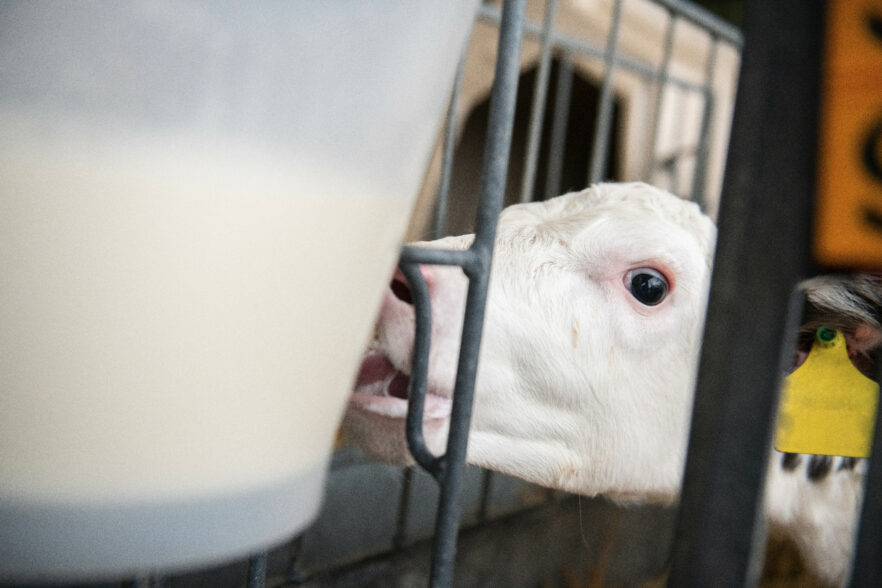
4. Check the temperature of the feed
Calves are used to cold milk when feeding ad libitum. The temperature of the milk is not particularly important in this case.
However, when feed is rationed, a suitable temperature of at least 35 °C, preferably 38-39 °C, should be maintained. The following measures can help:
- Stir the milk in the MilkTaxi a few degrees warmer. A drop in temperature must be offset when filling buckets, especially if the feed buckets are cold.
- Keep the lid closed during transport in the MilkTaxi. A great deal of energy is lost through an open lid. At extreme temperatures < -10 °C, the MilkTaxi blanket should also be used to prevent the milk from cooling down during feeding.
- A lid on the teat bucket also retains the heat in the milk much longer than with an open bucket.
- The milk hoses on the calf feeder should be insulated. Hose heating can help with very long milk pipes (> 5 m). However, it is important to monitor the temperature. If the cable heats up too much, the milk in the hose may get too hot.
5. Giving colostrum
Early colostrum is not only important for the calves' immune system. In addition to valuable antibodies, it also provides a newborn calf with a great deal of energy and other important nutrients. This is very valuable because newborn calves only have about 3–4 % fat reserves. These energy resources are used up within 12–24 hours in winter. This is why, in addition to the first meal, which should be given within a maximum of 2 hours to build up immunity, a second colostrum feed after approx. 12 hours is very important, especially in winter.
6. Increase concentrated feed intake
Concentrated feed and roughage are another way of providing calves with more energy alongside milk.
In winter it is even more important to ensure that calves readily eat concentrated feed, hay and silage. Moist silage can freeze in frosty conditions and should not be provided. Concentrated feed should also be stored frost-free if possible and supplied fresh daily.
However, it should be noted that the concentrate intake of young calves is too low. Calves only start to eat more dry feed after about 4–5 weeks. And increasing the amount of concentrated feed is only really beneficial in the weaning phase.
More energy can therefore only be reliably provided by way of additional milk.
7. Water
In winter there is a risk of water troughs freezing. The water bowls at calf hutches also freeze, so that often no water is available at all when it freezes.
However, water is essential if the intake of concentrate and roughage is to be encouraged. The newly developing rumen needs water so that a stable bacterial population can develop. It is estimated that at least 4 litres of water must be consumed for each kilogram of concentrate intake. In addition to the milk feed.
Water should be at a moderate temperature to ensure that the calves are happy to drink it. It can therefore make sense to provide warm water (approx. 20–30 °C) in winter. This can either be filled into buckets using the MilkTaxi or provided in calf groups via electrically heated float troughs.
Another reason to supply preheated water is that a calf has to warm up cold water using its own body heat. This energy is not available for growth.
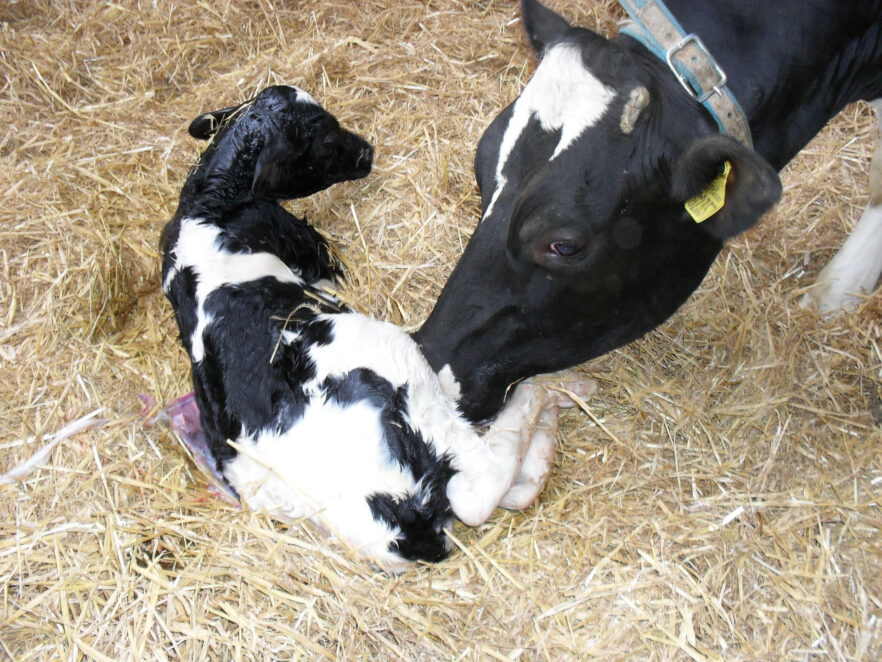
8. Calving assistance
A newborn calf emerges from a 38 °C environment in the womb. So the cold shock after birth is enormous. It is therefore important in winter for the calf to be quickly rubbed down and dried by the mother or the farmer. A wet calf loses a lot of energy – unlike a dry one. This is especially important following a difficult birth, when the mother cow and calf are very stressed.
You should use a large terry towel when drying a calf by hand. Rub the calf down vigorously and make sure that its hair stands up; this will then already provide the calf with a certain amount of heat insulation.
Of course, a dry and generously bedded calving pen provides additional heat protection.
Calves that have cooled down can be nursed back to health with heat lamps, in special heat boxes or even small heated rooms. They should only be placed in individual pens when they are completely dry.
In special emergencies, i.e. with severely hypothermic calves, even a bath with warm water (max. 38 °C!) should be used to quickly bring the calf's body temperature back up to normal.
9. Calf jackets or blankets
Calf jackets save about 20–30 % energy and can therefore also be used as an alternative to increased milk volumes. The jackets are particularly beneficial for young calves because they warm their backs. It has been shown that the lungs of newborn calves need about 2-3 weeks to develop fully. Lung "ventilation" starts from the top and leads downwards. This means that calf jackets are good at protecting the sensitive area of the lungs below the back.
A comparative study at Harpers University[1] in the UK found that calf jackets helped calves achieve higher gains with better health. In addition, the animals can convert their feed better and the overall costs per day of rearing and kg weight gain are reduced.
Calf jackets should therefore be used for all calves up to 3–4 weeks of age as soon as temperatures drop below 10 °C. As a general guideline, you could say: as soon as humans need a winter jacket, calves should also be granted this comfort. Any blanket should be removed when temperatures start to rise again and the calves begin to sweat. This can also be the case when calves take in more concentrate and rumen activity, and hence their own heat production, increases. You should therefore check whether jackets are still useful for calves over the age of 4–5 weeks.
With calf jackets, the blankets should definitely fit well. They must be washable and should be washed at a minimum of 30 °C at the latest when transferred to another calf.
Ear warmers look particularly odd on calves. However, what is often ridiculed in Europe is a very good solution in many parts of North America to prevent calves' ears from freezing. Since protruding ears have a large surface area and, in addition, little protection in the form of fur and hair, they are often the first part of the body to actually suffer from frostbite.
[1] Simon P. Marsh et.al, 2014, “Evaluation of calf coats (Holm & Laue) on the performance and health of artificially reared winter born beef calves to 12 weeks”
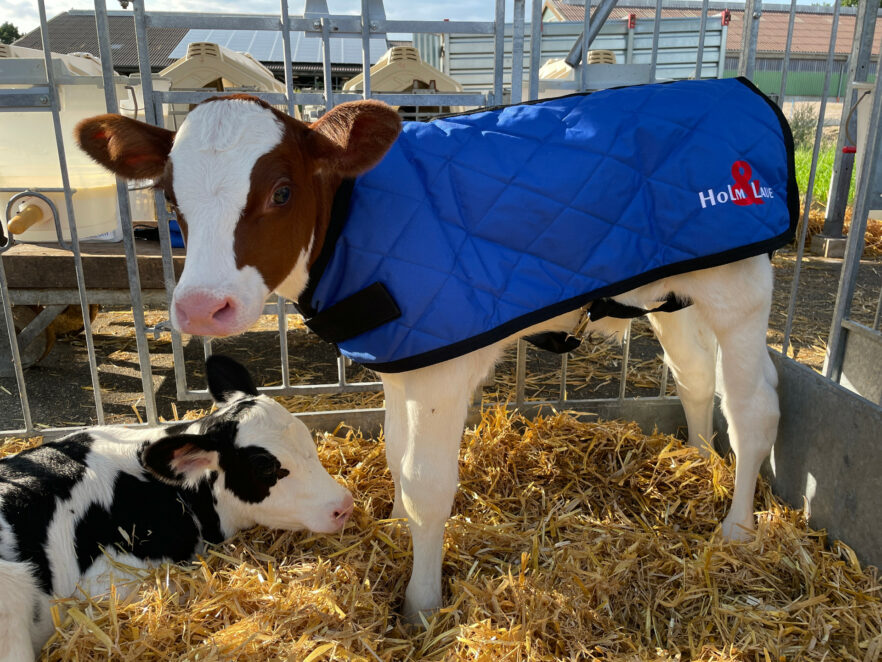
10. Bedding (nesting score)
Calves spend about 90% of their time lying down, especially in the first 2–3 weeks of life. So bedding is very, very important, especially in the cold season.
The animals can build their own nest with plenty of straw in the calf box and thereby protect themselves from the cold. It is important that the bedding is dry. Contact with damp straw or a compact straw mat will greatly cool the calf's body, and both are not very suitable for nest building. Drainage or slurry drains under the calf hutches help keep bedding dry.
It has been shown that a base of sawdust or sawdust with straw not chopped too short as a topper is an ideal combination.
You can check for sufficient bedding using the nesting score. It distinguishes between three situations:
- Score 1: the calf is lying on the bedding. All extremities are visible.
- Score 2: the calf is partly lying in the bedding. Feet and joints have disappeared into the straw, but legs are still visible.
- Score 3: The calf is lying deep in the straw, legs are no longer visible.
Score 3 should be attained for all calves in winter. On the other hand, score 1 is preferable in summer to prevent heat stress. Read the blog "It's gonna be hot, hot, baby!" for more on this topic.
Plenty of good bedding also ensures that calves stay clean. A dirty and sticky coat has little insulating effect.
11. Control draughts and wind
Calves need sufficient fresh air, especially in winter. Calves are exposed to stress during cold weather and should not be exposed to additional pollutants or germs in the air.
However, low temperatures also mean that there will be attempts to reduce ventilation to a minimum in order to prevent the calf pen from cooling down too much.
Calves can also survive low temperatures down to -20 °C well by undertaking the measures described above. However, calves are very sensitive when it comes to draughts. They must be avoided at all costs. Draughts occur in closed calf pens due to poorly controlled ventilation, in outdoor climate pens or calf hutches due to the wind blowing into where the calves are lying.
The following measures must therefore be taken in the barn:
- Weather stations should regulate the control of ventilation and extraction when mechanical ventilation with ducts or fans is used.
- Calf nests or side partitions interrupt unwanted air flows. Attention: However, they obstruct air flows from ducts or similar.
- Individual or group boxes with calf hut or igloo (outdoors but also indoors) afford maximum protection in the lying area.
- Outdoor calf hutches or igloos need basic roofing (like the CalfGarden or IglooVeranda). This creates a special microclimate for the calves, keeps their bedding dry and provides a pleasant and protected workplace.
- The facing direction of the igloo opening should be such that neither the main wind direction (for example, west-north-west) nor typical winter weather conditions (for example, north-east) blow into the igloo.
- Lateral wind breaks (either at the height of the fencing or by means of dense fences and hedges) reduce calves' exposure to wind in the lying area.
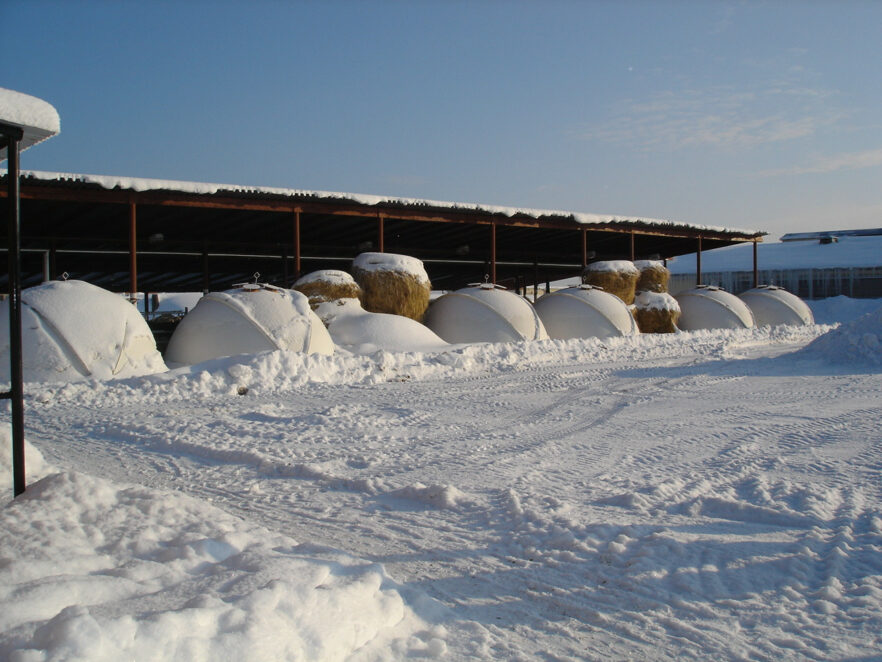
12. Be prepared for emergencies
Every well-intentioned tip or every well thought-out work routine is of no use if many factors come together in winter that make it impossible to care for your calves adequately. It is often not possible to provide good care for your calves if electricity goes down for an extended period of time, or if water pipes freeze or extreme snowfall makes it impossible to reach the calf igloos without first having spent two hours clearing snow and thawing water pipes.
For this reason, draw up an emergency plan in advance that describes exactly who has to do what and when in the event of a critical situation. Specify exactly what support your team can request. Prepare telephone lists, location plans for relief material and first aid. But also make sure you order things like gritting salt, brooms and shovels, sufficient fodder reserves (at least 2 weeks' supply), medicines, calf jackets etc. in good time. Make sure that your most important working machines are well maintained, fully fuelled and ready for use.
P.S.: this tip naturally applies to the entire farm and should be prepared in a joint team effort.
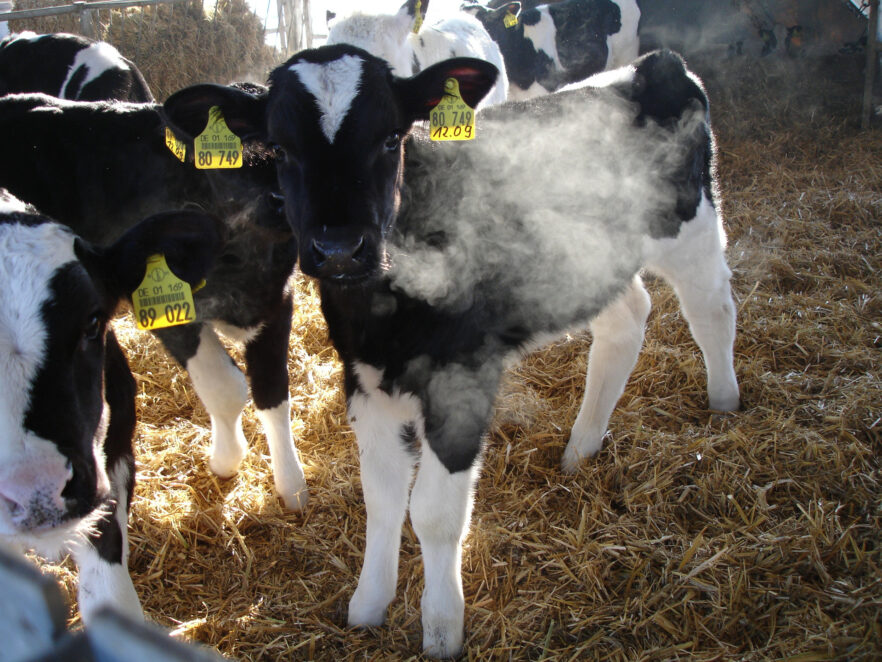
This blog article was written taking inspiration from the "Cold Weather Calf Management & Feeding" webinar in December 2021. In some cases I found useful advice and information in the two blogs by CalfTel and CalfStar, which I elaborated here. It is certainly worth taking a look at them. Many thanks to the authors Kelly Driver and Minnie Ward.
If you would like to know more about the "why", you can also read the first part of this article here on the blog.

